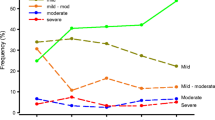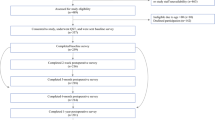Abstract
The purpose of this study was to investigate and report prevalence and risk factors for persistent pain in breast cancer patients at 15 months and 7–9 years post surgery. A nationwide inception cohort study including 3343 women treated for primary breast cancer between 2001 and 2004, who returned a questionnaire 3 months post surgery. Socio-demographic and clinical information was obtained from registries. Questionnaire data on pain and health behaviors were obtained 15 months and 7–9 years post surgery. A total of 1905 women were eligible for analysis. At 15-month post surgery, 32.7 % reported pain “almost every day” or more frequently. At 7–9 years post surgery, the prevalence decreased to 20.4 %. Socio-demographic (young age, lower education, lower income, lower occupational status), treatment-related (being lymph node positive, axillary lymph node dissection (ALND), post-menopausal endocrine treatment), and health behavioral factors (smoking ≥ 10 cigarettes/day, obesity (BMI ≥ 30 and < 35), comorbidity, poor physical function) were significantly associated with pain at 15 months. Being physically active and moderate alcohol intake (<3 units/day) were negatively associated with pain. At 7–9 years post surgery, only ALND (OR:1.41, p = 0.03), post-menopausal endocrine treatment (OR:1.62, p = 0.01), poorer physical function (ORs:2.00–2.40, p = 0.003), and weight training (h/week) at 15 months (OR:1.10, p = 0.008) were significant predictors of pain when adjusting for age and pain 15 months post surgery. No socio-demographic predictors remained statistically significant. Younger age, lower socio-economic status, more invasive surgery, endocrine treatment, and adverse health behaviors emerged as risk factors for persistent pain. The influence of risk factors changed over time, suggesting a complex course of pain development and maintenance.

Similar content being viewed by others
References
Andersen KG, Kehlet H (2011) Persistent pain after breast cancer treatment: a critical review of risk factors and strategies for prevention. J Pain 12(7):725–746
Kehlet Jensen TS, Woolf CJ (2006) Persistent postsurgical pain: risk factors and prevention. Lancet 367:1625–1628
Gärtner R, Nielsen J, Ewertz M et al (2009) Prevalence of and factors associated with persistent pain following breast cancer surgery. JAMA 302(18):1985–1992
Peuckmann V, Ekholm O, Rasmussen NK et al (2009) Chronic pain and other sequelae in long-term breast cancer survivors: nationwide survey in Denmark. Eur J Pain 13(5):478–485
Anderson KO, Reyes-Gibby CC (2013) Biopsychosocial approach to persistent post-mastectomy pain: what can we conclude? Pain 154(5):623–624
Poleschuk EL, Katz J, Andrus CH et al (2006) Risk factors for chronic pain following breast cancer surgery: a prospective study. J Pain 7(9):626–634
Fernández-Lao C, Cantarero-Villanueva I, Fernández-de-las-Peñas C et al (2011) Widespread mechanical pain hypersensitivity as a sign of central sensitization after breast cancer surgery: comparison between mastectomy and lumpectomy. Pain Med 12(1):72–78
Bianco PD, Zavagno G, Burelli P et al (2008) Morbidity comparison of sentinel lymph node biopsy versus conventional axillary lymph node dissection for breast cancer patients: results of the sentinella-GIVOM Italian randomised clinical trial. Eur J Surg Oncol 34(5):508–513
Steegers MA, Wolters B, Evers AW et al (2008) Effect of axillary lymph node dissection on prevalence and intensity of chronic and phantom pain after breast cancer surgery. J Pain 9(9):813–822
Jung BF, Ahrendt GM, Oaklander AL et al (2003) Neuropathic pain following breast cancer surgery: proposed classification and research update. Pain 104:1–13
Levy MH, Chwistek M, Mehta R (2008) Management of chronic pain in cancer survivors. Cancer J 14(6):401–409
Mejdahl M, Andersen K, Gärtner R et al (2013) Persistent pain and sensory disturbances after treatment for breast cancer: six year nationwide follow-up study. BMJ 1865(April):1–14
Noeres D, Park-Simon T-W, Grabow J et al (2013) Return to work after treatment for primary breast cancer over a 6-year period: results from a prospective study comparing patients with the general population. Support Care Cancer 21(7):1901–1909
Miaskowski C, Cooper B, Paul SM et al (2012) Identification of patient subgroups and risk factors for persistent breast pain following breast cancer surgery. J Pain 13(12):1172–1187
Eaker S, Wigertz A, Lambert PC, Bergkvist L et al (2011) Breast cancer, sickness absence, income and marital status. A study on life situation 1 year prior diagnosis compared to 3 and 5 years after diagnosis. PLoS One 6(3):e18040
Rief W, Barwell WA, Dimsdale JE et al (2011) Long-term course of pain in breast cancer survivors: a 4-year longitudinal study. Breast Cancer Res Treat 130:579–586
Ditre JW, Gonzalez BD, Simmons VN et al (2011) Associations between pain and current smoking status among cancer patients. Pain 152(1):60–65
Ditre JW, Brandon TH, Zale EL et al (2011) Pain, nicotine, and smoking: research findings and mechanistic considerations. Psychol Bull 137(6):1065–1093
Patterson AL, Gritzner S, Resnick MP et al (2012) Smoking cigarettes as a coping strategy for chronic pain is associated with greater pain intensity and poorer pain-related function. J Pain 13(3):285–292
Sipilä R, Estlander AM, Tasmuth T, Kataja M et al (2012) Development of a screening instrument for risk factors of persistent pain after breast cancer surgery. Br J Cancer 107(9):1459–1466
Forsythe LP, Alfano CM, George SM et al (2013) Pain in long-term breast cancer survivors: the role of body mass index, physical activity, and sedentary behavior. Breast Cancer Res Treat 137(2):617–630
Caffo O, Amichetti M, Ferro A et al (2003) Pain and quality of life after surgery for breast cancer. Breast Cancer Res Treat 80(1):39–48
MacDonald L, Bruce J, Scott NW et al (2005) Long-term follow-up of breast cancer survivors with post-mastectomy pain syndrome. Br J Cancer 92:225–230
Jim HSL, Small BJ, Minton S et al (2012) History of major depressive disorder prospectively predicts worse quality of life in women with breast cancer. Ann Behav Med 43(3):402–408
Bair MJ, Robinson RL, Katon W et al (2003) Depression and pain comorbidity: a literature review. Arch Intern Med 163(20):2433–2445
Christensen S, Zachariae R, Jensen AB et al (2009) Prevalence and risk of depressive symptoms 3–4 months post-surgery in a nationwide cohort study of Danish women treated for early stage breast-cancer. Breast Cancer Res Treat 113(2):339–355
Singletary S (2002) Revision of the American joint committee on cancer staging system for breast cancer. J Clin Oncol 20(17):3628–3636
Rostgaard K, Holst H, Mouridsen HT et al (2000) Do clinical databases render population-based cancer registers obsolete? The example of breast cancer in Denmark. Cancer Causes Control 11(7):669–674
Møller S, Jensen M, Ejlertsen B et al (2008) The clinical database and the treatment guidelines of the Danish Breast Cancer Cooperative Group (DBCG); its 30-years experience and future promise. Acta Oncol 47(4):506–524
Gjerstorff ML (2011) The Danish cancer registry. Scand J Public Health 39(7 Suppl):42–45
Charlson ME, Pompei P, Ales KL et al (1987) A new method of classifying prognostic comorbidity in longitudinal studies: development and validation. J Chronic Dis 40(5):373–383
Extermann M (2000) Measurement and impact of comorbidity in older cancer patients. Crit Rev Oncol Hematol 35(3):181–200
World Health Organization (WHO) (2000) Obesity. Preventing and managing the global endemic. Geneva: Technial Report Series no 894
Washburn RA, Smith KW, Jette AM et al (1993) The Physical Activity Scale for the Elderly (PASE): development and evaluation. J Clin Epidemiol 46(2):153–162
Ware JE, Sherbourne CD (1992) The MOS 36-Item short-form health survey (SF-36). Med Care 30(6):473–483
Ashing-Giwa KT, Lim J (2009) Examining the impact of socioeconomic status and socioecologic stress on physical and mental health quality of life among breast cancer survivors. Oncology 36(1):79–88
Jakesz R, Jonat W, Gnant M et al (2005) Switching of postmenopausal women with endocrine-responsive early breast cancer to anastrozole after 2 years’ adjuvant tamoxifen: combined results of ABCSG trial 8 and ARNO 95 trial. Lancet 366(9484):455–462
Presant CA, Bosserman L, Young T et al (2007) Aromatase inhibitor-associated arthralgia and/or bone pain: frequency and characterization in non-clinical trial patients. Clin Breast Cancer 7(10):775–778
Crew KD, Greenlee H, Capodice J et al (2007) Prevalence of joint symptoms in postmenopausal women taking aromatase inhibitors for early-stage breast cancer. J Clin Oncol 25(25):3877–3883
Alfano CM, Smith AW, Irwin ML et al (2007) Physical activity, long-term symptoms, and physical health-related quality of life among breast cancer survivors: a prospective analysis. J Cancer Surviv 1(2):116–128
Kwon JH (2014) Overcoming barriers in cancer pain management. J Clin Oncol 32(16):1727–1733
Deandrea S, Montanari M, Moja L et al (2008) Prevalence of undertreatment in cancer pain. A review of published literature. Ann Oncol 19(12):1985–1991
Melzack R (1975) The McGill pain questionnaire: major properties and scoring methods. Pain 1(1):277–299
Acknowledgments
We thank the participating women and the Danish Breast Cancer Cooperative Group (DBCG), Rigshospitalet, Copenhagen University Hospital, for providing the clinical data. This research was generously supported by The Danish Cancer Society (PP05020, PP03034), IMK Almene Fond (30206-215), and The Aase and Ejnar Danielsen Foundation (106318).
Author information
Authors and Affiliations
Corresponding author
Ethics declarations
Conflict of interest
The authors declare that they have no conflicts of interest.
Rights and permissions
About this article
Cite this article
Johannsen, M., Christensen, S., Zachariae, R. et al. Socio-demographic, treatment-related, and health behavioral predictors of persistent pain 15 months and 7–9 years after surgery: a nationwide prospective study of women treated for primary breast cancer. Breast Cancer Res Treat 152, 645–658 (2015). https://doi.org/10.1007/s10549-015-3497-x
Received:
Accepted:
Published:
Issue Date:
DOI: https://doi.org/10.1007/s10549-015-3497-x




